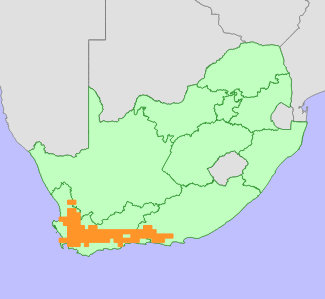| Scientific Name | Leucadendron rubrum Burm.f. | Higher Classification | Dicotyledons | Family | PROTEACEAE | Synonyms | Leucadendron plumosum (Aiton) R.Br. | Common Names | Dikkopeierbos (a), Spinning Top (e), Tolbos (a), Tolletjiesbos (a) |
National Status | Status and Criteria | Least Concern | Assessment Date | 2019/06/18 | Assessor(s) | A.G. Rebelo, H. Mtshali & L. von Staden | Justification | Leucadendron rubrum is widespread, abundant, and not in danger of extinction. It is therefore assessed as Least Concern. |
Distribution | Endemism | South African endemic | Provincial distribution | Eastern Cape, Northern Cape, Western Cape | Range | This species is extremely widespread in the mountains of the Cape Floristic Region. It occurs from the Bokkeveld Escarpment, Gifberg and Cederberg southwards to the Hottentots-Holland Mountains, and eastwards along the Swartberg, Langeberg, Outeniqua and Kouga mountains to the Baviaanskloof. It also occurs on the Cape Peninsula and Cape Flats at Fisantekraal. |
Habitat and Ecology | Major system | Terrestrial | Major habitats | Matjiesfontein Shale Fynbos, Kouebokkeveld Alluvium Fynbos, Kogelberg Sandstone Fynbos, Hawequas Sandstone Fynbos, Bokkeveld Sandstone Fynbos, Grootrivier Quartzite Fynbos, Breede Quartzite Fynbos, Matjiesfontein Quartzite Fynbos, Swartruggens Quartzite Fynbos, Montagu Shale Fynbos, Elgin Shale Fynbos, Cape Winelands Shale Fynbos, South Sonderend Sandstone Fynbos, Swartberg Shale Fynbos, North Langeberg Sandstone Fynbos, Kouebokkeveld Shale Fynbos, Robertson Granite Fynbos, Peninsula Granite Fynbos, Boland Granite Fynbos, Breede Sand Fynbos, Swellendam Silcrete Fynbos, Eastern Inland Shale Band Vegetation, Central Inland Shale Band Vegetation, Western Coastal Shale Band Vegetation, Northern Inland Shale Band Vegetation, Swartland Alluvium Fynbos, Breede Alluvium Fynbos, Breede Shale Fynbos, Kouga Grassy Sandstone Fynbos, Matjiesfontein Shale Renosterveld, Ceres Shale Renosterveld, Swartberg Shale Renosterveld, Kango Limestone Renosterveld, Swartland Granite Renosterveld, Kango Conglomerate Fynbos, Peninsula Sandstone Fynbos, South Hex Sandstone Fynbos, North Hex Sandstone Fynbos, Piketberg Sandstone Fynbos, Winterhoek Sandstone Fynbos, North Sonderend Sandstone Fynbos, Olifants Sandstone Fynbos, Breede Shale Renosterveld, Kouga Sandstone Fynbos, South Kammanassie Sandstone Fynbos, North Kammanassie Sandstone Fynbos, South Swartberg Sandstone Fynbos, North Swartberg Sandstone Fynbos, South Rooiberg Sandstone Fynbos, North Rooiberg Sandstone Fynbos, Tsitsikamma Sandstone Fynbos, Graafwater Sandstone Fynbos, South Outeniqua Sandstone Fynbos, North Outeniqua Sandstone Fynbos, South Langeberg Sandstone Fynbos, Cederberg Sandstone Fynbos | Description | It occurs on steep, dry granite and sandstone slopes in montane fynbos, 100-1900 m. Mature individuals are killed by fires, and only seeds survive. Wind-dispersed seeds are stored in fire-resistant inflorescences, and released after fires. It is dioecious, with wind-pollinated male and female flowers occurring on separate plants. |
Threats | | About 14% of this species' habitat is irreversibly modified, due to historical habitat loss to vineyards, timber plantations and fruit orchards. There is ongoing, slow habitat loss, and a combination of climate change and habitat loss models predicted that this species could decline by more than 30% by 2025 (Bomhard et al. 2005). No such drastic reductions has been observed, mainly because this species predominantly occurs in steep slopes that are unsuited to cultivation, and the overall rate of habitat loss recorded between 1990 and 2014 is 1%.
Alien invasive plants are spreading, and increasing in density in the mountains of the Western Cape, and are likely to outcompete native species such as L. rubrum if not urgently cleared.
It was classified as an agricultural weed in the past, and herbicide control was advised (Wells et al. 1986). |
Population | This species typically occur in extensive, dense stands, and is only occasionally encountered as scattered plants (Rebelo 2001). There is very slow, ongoing loss of habitat on lower, less steep slopes, but this is unlikely to result in a population reduction of more than 5% in three generations.
| Population trend | Stable |
Assessment History |
Taxon assessed |
Status and Criteria |
Citation/Red List version | | Leucadendron rubrum Burm.f. | Least Concern | Raimondo et al. (2009) | |
Bibliography | Bomhard, B., Richardson, D.M., Donaldson, J.S., Hughes, G.O., Midgley, G.F., Raimondo, D.C., Rebelo, A.G., Rouget, M. and Thuiller, W. 2005. Potential impacts of future land use and climate change on the Red List status of the Proteaceae in the Cape Floristic Region, South Africa. Global Change Biology 11(9):1452-1468.
Goldblatt, P. and Manning, J.C. 2000. Cape Plants: A conspectus of the Cape Flora of South Africa. Strelitzia 9. National Botanical Institute, Cape Town.
Raimondo, D., von Staden, L., Foden, W., Victor, J.E., Helme, N.A., Turner, R.C., Kamundi, D.A. and Manyama, P.A. 2009. Red List of South African Plants. Strelitzia 25. South African National Biodiversity Institute, Pretoria.
Rebelo, T. 2001. Sasol Proteas: A field guide to the proteas of southern Africa. (2nd ed.). Fernwood Press, Vlaeberg, Cape Town.
Wells, M.J., Balsinhas, A.A., Joffe, H., Engelbrecht, V.M., Harding, G. and Stirton, C.H. 1986. A catalogue of problem plants in southern Africa. Memoirs of the Botanical Survey of South Africa 53. Botanical Research Institute and Department of Agriculture and Water Supply, Pretoria.
|
Citation | | Rebelo, A.G., Mtshali, H. & von Staden, L. 2019. Leucadendron rubrum Burm.f. National Assessment: Red List of South African Plants version 2024.1. Accessed on 2025/10/25 |
 Comment on this assessment Comment on this assessment
|
 © D. Turner  © D. Turner  © S. Falanga  © Outramps  © Outramps
Search for images of Leucadendron rubrum on iNaturalist
|
 Comment on this assessment
Comment on this assessment

